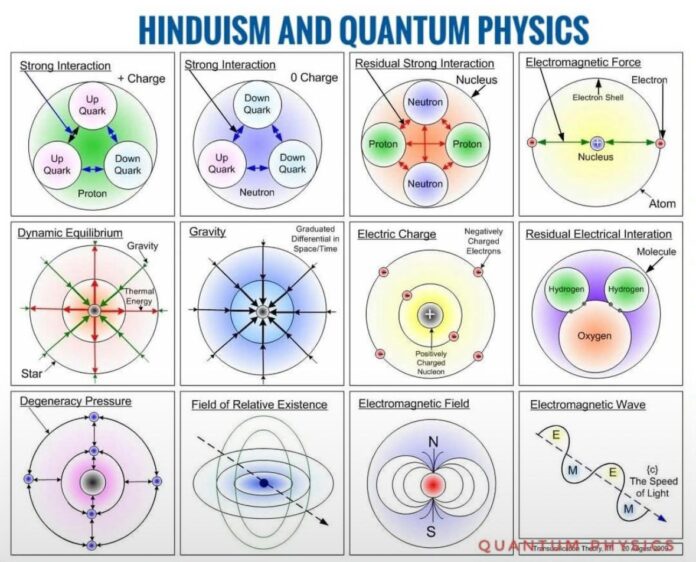Are the roots of quantum physics found in the Vedas? While quantum physics as a modern scientific discipline did not directly derive from the Vedas, there are remarkable philosophical parallels and historical influences that connect the two.
Philosophical Parallels
Unity of Existence: Both quantum physics and the Vedas emphasize the interconnectedness of all things. Quantum entanglement shows that particles can instantaneously affect each other across vast distances, echoing the Vedic concept of Advaita (non-duality) and the oneness of Brahman—the ultimate, all-pervading reality.
ॐ ईशा वास्यमिदँ सर्वं यत्किञ्च जगत्यां जगत् ।
तेन त्यक्तेन भुञ्जीथा मा गृधः कस्यस्विद्धनम् II
“All this- whatever exists in this changing universe, is pervaded by consciousness” (Isa Upanishad)
ब्रह्मैवेदममृतं पुरस्तात् ब्रह्म पश्चात् ब्रह्म उत्तरतो दक्षिणतश्चोत्तरेण ।
अधश्चोर्ध्वं च प्रसृतं ब्रह्मैवेदं विश्वमिदं वरिष्ठम् ॥ (2.2.11)
This is a reference to the Mundaka Upanishad mantra (above) in which the Vedic understanding of the connectivity of living entities is put forward to help the Bhakta (practitioner of yoga) to understand the difference between the body and the living entity. How the real nature of the living entity is realized only in union with the source, the supreme being (Brahman/Krishna) through a platform of transcendental divine loving service. (Schrodinger wrote in his book Meine Weltansicht) In speaking of a universe in which particles are represented by wave functions, said:
“The unity and continuity of Vedanta are reflected in the unity and continuity of wave mechanics. This is entirely consistent with the Vedanta concept of All in One. There is no kind of framework within which we can find consciousness in the plural; this is simply something we construct because of the temporal plurality of individuals, but it is a false construction. The only solution to this conflict insofar as any is available to us at all lies in the ancient wisdom of the Upanishad.” (Source: Mein Leben, Meine Weltansicht – My Life, My World View, 1961, Chapter 4)
Role of the Observer: In quantum mechanics, the act of observation collapses a particle’s wave function, determining its state. This resonates with Vedic teachings that consciousness shapes reality, as seen in the Upanishadic idea that the observer and the observed are ultimately the same.
Illusion and Reality: The Vedic concept of maya (illusion) suggests that the world we perceive is not the ultimate reality, paralleling quantum theory’s probabilistic and non-deterministic nature.
Influence on Quantum Pioneers
Erwin Schrodinger, Niels Bohr, and Werner Heisenberg—key founders of quantum mechanics—were deeply influenced by Vedic and Upanishadic texts.



